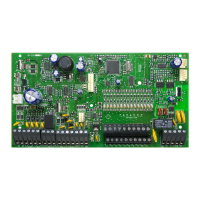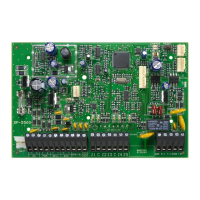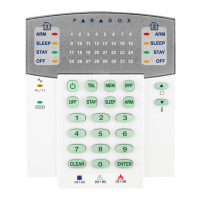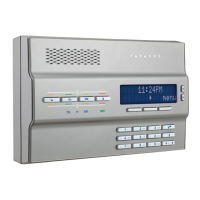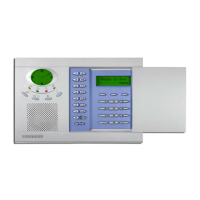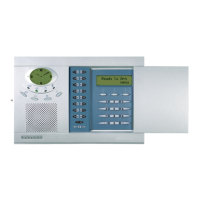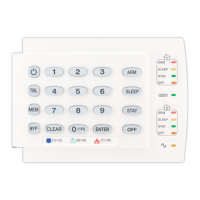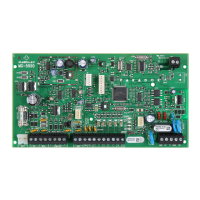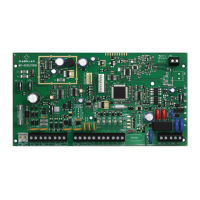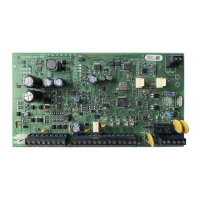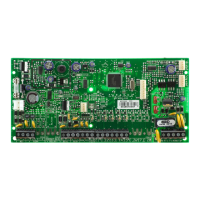
Do you have a question about the Paradox Magellan MG5050E and is the answer not in the manual?
| Partitions | 2 |
|---|---|
| Keypads | 8 |
| Wireless Frequency | 433 MHz or 868 MHz |
| StayD Mode | Yes |
| Remote Control Support | Yes |
| Event Log/Buffer | 256 events |
| System Type | Hybrid Alarm System |
| Users | 32 |
| Battery Backup | 12V 7Ah |
| Operating Temperature | 0°C to 49°C |
| Humidity | 5% to 90% non-condensing |
| Zones | 32 |
Overview of system capabilities and functionalities.
High-level description of the system architecture and components.
Technical specifications for MG and SP series control panels.
Guidelines for installation site, grounding, AC, and battery connections.
Requirements for meeting EN 50131 security standards.
Diagrams detailing PCB layouts for MG5000, MG5050, and MG5075 models.
Diagrams detailing PCB layouts for SP4000, SP5500, SP6000, SP7000 models.
Instructions for mounting PCBs in metal enclosures and installing tamper kits.
Instructions for mounting the MG5075 PCB in its plastic enclosure.
Usage and limitations of auxiliary power terminals for system components.
Procedures for connecting telephone lines and bell outputs.
Overview of PGMs and their connection options for event-triggered outputs.
Diagrams for connecting single zone inputs using NC/NO contacts with/without EOL resistors.
Diagrams for ATZ connections, including NC contacts and parallel wiring.
Diagrams for 4-wire and 2-wire fire circuit installations and PGM connections.
Using BabyWare and keypads for system programming.
Viewing programmed section data one digit at a time.
Process for assigning a zone number to a keypad for system recognition.
Procedures for copying and downloading programs using the Memory Key.
Mapping of function keys, alphanumeric input, and label sections.
Overview of special character mapping for various languages on keypads.
Key assignments for Hebrew and Greek language input on keypads.
Key assignments and special character catalogue for Russian language input.
Description of code types (Installer, Master, User) and length configuration.
Procedures for setting or changing Installer, Maintenance, and Master Codes.
User code options for partition assignment, bypass, and arming methods.
User code options for PGM activation, duress alarms, and master code locking.
Explanation of StayD mode, entry/exit paths, and keypad/remote operation.
Functionality for opening exterior zones and re-arm delay settings.
How zones are recognized and the meaning of various zone definitions.
Programming Entry Delay 1 and 2 for zones, including full arm states.
Behavior of Delayed Fire, Instant Fire Silent, and 24 Hr. Buzzer zones.
Behavior of 24-hour burglary, hold-up, gas, heat, and water zones.
Behavior of Freeze, Panic, Instant No Pre-Alarm, and Follow No Pre-Alarm zones.
Assigning zones to Partition 1, Partition 2, or both.
Options for zone shutdown, bypass, and wireless supervision.
Options for alarm behavior, Intellizone, and delayed alarm transmission.
Options for force zones, EOL resistors, and ATZ zone doubling.
Configuring tamper inputs, ATZ wiring, and zone response timers.
Defining keyswitch usage (Maintained/Momentary) and programming options.
Assigning, programming, and supervising wireless transmitters.
Checking signal strength of installed wireless transmitters.
Setting the interval for wireless transmitter check-in signals.
Enabling RF jamming detection and viewing wireless module serial numbers.
Process for assigning and removing remote controls from the system.
Assigning functions to buttons on programmable remote controls.
Assigning wireless keypads and checking their signal strength.
Configuring keypad supervision and live display modes.
Process for assigning and removing wireless repeaters.
Checking signal strength for installed wireless repeaters.
Configuration options for repeaters, including supervision and signal repetition.
Enabling or disabling zone signal repetition for repeaters.
Enabling or disabling 2WPGM signal repetition for repeaters.
Logic for Stay Arming and Follow zones becoming Entry Delay 2.
Options for switching arming modes and restricting arming on failures.
Preventing arming if wireless supervision troubles are detected.
Programming partitions to arm automatically at scheduled times.
Enabling auto-arming based on inactivity and setting the timer.
Enabling one-touch arming for Regular, Stay, and Sleep modes.
Configuring exit delay, keypad beeps, and bell squawks.
Options to disable exit delay or use fast exit feature.
Setting bell cutoff duration and alarm recycle parameters.
Configuring tamper recognition and RF supervision for modules.
Handling tamper events on bypassed zones and bus module supervision.
Panel tamper supervision for MG5075 and keypad panic configurations.
Setting panic lockout timer and Flex-Instant delay for false alarm prevention.
Programming report codes for zones, users, and specific arming events.
Report codes for special disarming and alarm types like Duress.
Report codes for system troubles like AC failure, battery, and RF issues.
Report codes for trouble restoration and system occurrences like Test Reports.
Options to clear or reset reporting codes to default values.
Programming telephone numbers for monitoring stations and personal contacts.
Choosing reporting formats (Ademco, SIA) for communication.
Defining which telephone numbers to call for different event types.
Selecting dialing method, pulse ratio, and configuring dialing attempts.
Setting delays between attempts and configuring alternate dialing.
Configuring delays for recent closing, auto test reports, and arm/disarm events.
Setting delays for reporting closing delinquencies and power failures.
Configuring when disarming events are reported.
Options for reporting when zones are restored to normal.
Enabling TLM and configuring behavior upon line test failures.
Configuring delays and repetition for pager and personal reports.
Option to disable all reporting functions.
Defining events that trigger PGM activation and deactivation.
Setting PGM delay and configuring PGM behavior options.
Configuring PGMs to pulse on specific conditions or partitions.
Process for assigning and removing PGMs from the system.
Checking signal strength for installed PGMs.
Features for viewing version, performing power reset, and enabling installer lock.
Settings for keypad lockout, battery charge, and system partitioning.
Settings for a confidential mode to hide keypad activity.
Accessing installer functions and configuring automatic DST adjustments.
Setting custom DST start/end periods based on country codes.
Enabling audible warnings for troubles, including AC failure.
Enabling display of entry and exit delays on K32LCD+ keypads.
Configuring panel answer settings and answering machine override for BabyWare.
Setting panel identifier, PC password, and telephone number for BabyWare.
Procedures for initiating and answering BabyWare software communication.
Enabling automatic upload of event buffer data to BabyWare.
Enabling panel to call back PC for enhanced security during communication.
Diagram illustrating the hardware connections for BabyWare software.
How alarms are displayed on the keypad and stored in memory.
Accessing and navigating the trouble display menu on the keypad.
